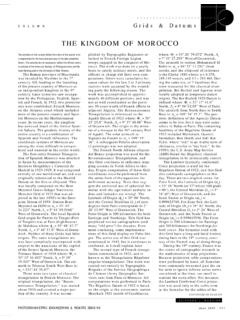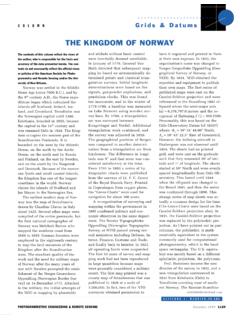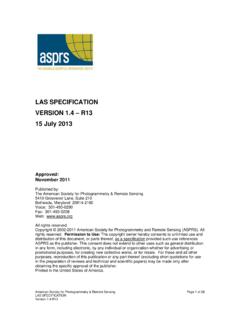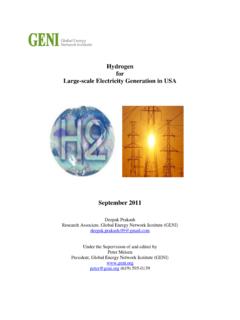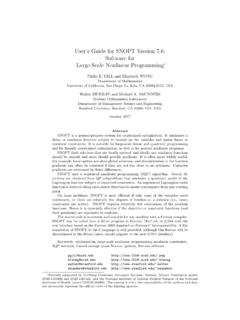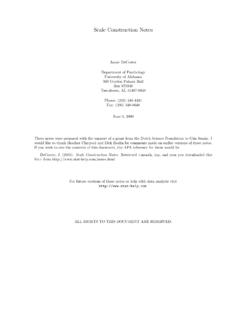Transcription of ASPRS ACCURACY STANDARDS FOR LARGE-SCALE …
1 ASPRS ACCURACY STANDARDS FOR LARGE-SCALE MAPS The American Society for Photogrammetry and Remote Sensing Approval by the ASPRS Professional Practicing Division, March, 1990 These STANDARDS have been developed by the Specifications and STANDARDS Committee of the American Society for Photogra mmetry and Remote Sensing ( ASPRS ). It is anticipated that these ASPRS STANDARDS may form the basis for revision of the National Map ACCURACY STANDARDS for both small- scale and LARGE-SCALE maps. A major feature of these ASPRS STANDARDS is that they indicate ACCURACY at ground scale . Thus, digital spatial data of known ground- scale ACCURACY can be related to the ap-propriate map scale for graphic presentation at a recognized standard. These STANDARDS concern the definitions of spatial ACCURACY as they pertain to LARGE-SCALE topographic maps prepared for special purposes or engineering applications. Emphasis is on the final spatial accuracies that can be derived from the map in terms most generally understood by the users.
2 1. Horizontal ACCURACY : Horizontal map ACCURACY is defined as the rms error! in terms of the project's planimetric survey coordinates(X,Y) for checked points as determined at full (ground) scale of the map. The rms error is the cumulative result of all errors including those intro-duced by the processes of ground control survevs, map compila-tion and final extraction of ground dimensions from the map. The limiting rms errors are the maximum permissible rms errors es-tablished by this standard. These limiting rms errors for Class 1. maps are tabulated in Table lE(feet) and Table 1M (meters) along with tvpical map scales associated with the limiting errors. These limits of ACCURACY apply to tests made on well-defined points only' Table 1E. -Planimetric Coordinate ACCURACY Requirement (Ground X or Y in feet) for Well defined Points Class 1. Maps PLANIMETRIC (X or Y) ACCURACY ' (limiting rms error, feet) TYPICAL MAP scale 1 :60 1:120 1 :240 ---------------oj ------------------------i :"3'6[) - - - - - - - - - - - - - 1:480 1:600 1:1,200 1:2,400 1:4,800 5~ 1:~000 1 :9,60() 1: 12,000 1:20,000 *indicates the practical limit for aerial methods -for scales above this line, ground methods are normally used.]
3 2. Vertical ACCURACY : Vertical map ACCURACY is defined as the rms error in evaluation in terms of the project's evaluation datum for well-defined points only. For Class 1. maps the limiting rms error in evaluation is set by the standard at one-third the indicated contour interval for well-d'efined points only. Spot heights shall be shown on the map within a limiting rms error of one-sixth of the contour interval. lsee Appendix A, Section A 1. 2see Appendix A, Section A2. Table 1E. -Planimetric Coordinate ACCURACY Requirement (Ground X or Y in feet) for WeI/-defined Points -Class 1. Maps PLANIMETRIC (X or Y) ACCURACY " (limiting rms error, meters) TYPICAL MAP scale 1:50 1:100 1:200 --- -------------------i:"5-0C) - - - - - - - - - - - 1: 1,000 1 :2,000 1 :4,00 1 :5,000 1:10,000 1 :20,000 *indicates the practical limit for aerial methods -for scales above this line ground methods ore normally used. 3. Lower- ACCURACY Maps: Map accuracies can also be defined at lower spatial ACCURACY STANDARDS .
4 Maps compiled within limiting rms errors of twice or three times the those allowed for a Class 1. map shall be desig-nated Class 2. or Class 3. maps respectively. A map may be com-piled that complies with one class of ACCURACY in elevation and an other in plan. Multiple accuracies on the same map are allowed provided a diagram is included which clearly relates segments of the map with the appropriate map ACCURACY class. 4. Map ACCURACY Test4: Tests for compliance of a map sheet are optional. Testing for horizontal ACCURACY compliance is done by comparing the planimetric (X and Y) coordinates of well-defined ground points to the coordinates of the same points as determined by a horizon-tal check survey of higher ACCURACY . The check survey shall be designed according to the Federal Geodetic Control Committee (FGCC) [FGCC, 1984] STANDARDS and specifications to achieve standard deviations equal to or less than olle-third of the "limiting rms error" selected for the distance between control points (d) used in the FGCC standard for the design of the survey shall be the horizontal ground distance across the diagonal dimension of the map sheet.
5 Testing for vertical ACCURACY compliance shall be accomplished by comparing the elevations of well-defined points as determined from the map to corresponding elevations determined by a sur-vey of higher ACCURACY . For purposes of checking elevations, the map position of the ground point may be shifted in any direction by an amount equal to twice the limiting rms error in position. The vertical check survey should be designed to produce rms er-rors in elevation differences at check point locations no larger than 1/20th of the contour interval. The distance (d) between bench marks used in the FGCC standard for the design of the vertical check survey shall be the horizontal ground distance across the diagonal of the map sheet. Generally, vertical control networks based on surveys conducted according to the FGCC STANDARDS for Third Order provide adequate ACCURACY for conducting the verti-cal check survey. 'see Appendix A., Section A3. 'see Appendix A, Section A4. ANNUAL REPORTS Discrepancies between the X, Y, or Z coordinates of the ground point, as determined from the map and by the check survey, that exceed three times the limiting rms error shall be interpreted as blunders and will be corrected before the map is considered to meet this standard.
6 The same survey datums, both horizontal and vertical, must be used for both the project and the check control surveys. Although a national survey datum is preferred, a local datum is acceptable. A minimum of 20 check points shall be established through-out the area covered by the map and shall be distributed in a manner agreed upon by the contracting parties5 Maps produced according to this spatial ACCURACY standard shall include the following statement in the title block: THIS MAP WAS COMPILED TO MEET THE ASPRS STANDARD FOR CLASS 1. MAP ACCURACY If the map was checked and found to conform to this spatial ACCURACY standard, the following statement shall also appear in the title block: THIS MAP WAS CHECKED AND FOUND TO CONFORM TO THE ASPRS STANDARD FOR CLASS 1. MAP ACCURACY APPENDIX A. EXPLANATORY COMMENTS A 1. Root Mean Square Error The "root mean square" (rms) error is defined to be the square root of the average of the squared discrepancies. In this case, the discrepancies are the differences in coordinate or elevation values as derived from the map and as determined by an in-dependent survey of higher ACCURACY (check survey).
7 For ex-ample, the rms error in the X coordinate direction can be computed as: rmsx \I(D2/n) where: D2 = d,2 + d22 + --------+ d/ d discrepancy in the X coordinate direction Xtnap -X,-hc,-k n total number of points checked on the map in the X coordinate direction A2. Well-defined Points The term" well-defined points" pertains to features that can be sharply identified as discrete points. Points which are not well-defined (that is poorly-defined) are excluded from the map ACCURACY test. In the case of poorly-defined image points, these may be of features that do not have a well-defined center such as roads that intersect at shallow angles [ National Map ACCURACY STANDARDS , 1941]. In the case of poorly defined ground points, these may be such features as soil boundaries or timber boundaries. As indicated in the ASPRS Standard, the selection of well-defined points is made through agreement by the con-tracting parties. A3. Relationship to National Map ACCURACY STANDARDS Planimetric ACCURACY in terms of the "limiting rms error" can be related to the United States National Map ACCURACY Stan-dards (NMAS) provided the following assumptions are made: 5see Appendix A.
8 , Section AS. -the discrepancies are normally distributed about a zero mean -the standard deviations in the X and Y coordinate directions are equal -sufficient check points are used to accurately estimate the variances To compute the "circular map ACCURACY standard" (CMAS) which corresponds to the 90% circular map error defined in the NMAS [ACIC, 1962, p. 26, p. 41]: CMAS = tTx or; CMAS = tTy Given these relationships and assumptions, the limiting rms errors correspond approximately to the CMAS of 1I47th of an inch for all errors and related scales indicated in Table 1 E. For the metric case indicated in Table 1M, the CMAS is mm for all rms errors and corresponding scales. It is emphasized that for the ASPRS Standard, spatial accuracies are stated and evaluated at full or ground scale . The measures in terms of equiv-alent CMAS are only approximate and are offered only to pro-vide a comparison to the National Map ACCURACY Standard of CMAS of 1I3 Oth inch at map scale .
9 A4. Check Survey Both the vertical and horizontal (planimetric) check surveys are designed based on the National STANDARDS of ACCURACY and field specifications for control surveys established by the Fed-eral Geodetic Control Committee (FGCC). These STANDARDS and specifications [FGCC, 1984] are intended to establish proce-dures which produce accuracies in terms of relative errors. For horizontal surveys, the proportional accuracies for the various orders and classes of survey are stated in Table of the FGCC document and for elevation ACCURACY in Table These tables along with their explanations are reproduced here. From FGCC [1984]: " HORIZONTAL CONTROL NETWORK STANDARDS When a horizontal control is classified with a particular order and class, NGS certifies that the geodetic latitude and longitude of that control point bear a relation of specific ACCURACY to the coordinates of all other points in the horizontal control network. This relationship is expressed as a distance ACCURACY , l:a.
10 A distance ACCURACY is the ratio of relative positional error of a pair of control points to the horizontal separation of those points. TABLE -DISTANCE ACCURACY STANDARDS Classification First-order.. Second-order, class I .. Second-order, class II.. Third-order, class I .. Third-order, class II .. Minimum distance ACCURACY 1:100,000 1: 50,000 1: 20,000 1: 10,000 1: 5,000 " A distance ACCURACY , l:a, is computed from a minimally constrained, correctly weighted, least squares adjustment by: a=d!s where a = distance ACCURACY denominator s = propagated standard deviation of distance between survey points obtained from the least squares adjustment d = distance between survey points" [(]70 I'HOTOCRi\\1l'vIFTR1C El\:Clf\IERINC & REMOTE SE.'.c.;INC, 19K9 "VERTICAL CONTROL NETWORK STANDARDS When a vertical control point is classified with a particular order and class, NCS certifies that the orthometric elevation at that point bears a relation of specific ACCURACY to the elevations of all other points in the vertical control network.)


